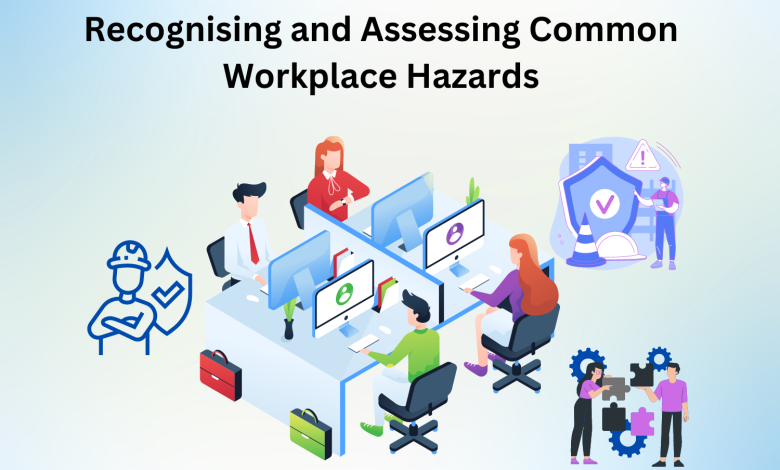
Every workplace is often worried about the possible accidents in a workplace. To keep a workplace safe and prevent Health and Safety Hazard its key to spot dangers like broken machines or harmful chemicals to stop accidents. Teaching workers through IOSH Courses helps them learn how to see and handle these risks. This makes the workplace safer and helps everyone work better and more safely together.
This blog will talk about the many dangers to health and safety at work and how to find and understand these dangers.
Table Of Contents
- What are the Types of Workplace Hazards?
- Assessing Common Workplace Hazards
- Conclusion
What are the Types of Workplace Hazards?
Many kinds of hazards might be considered common threats at workplace, and they have the potential to endanger the health and well-being of a worker. Physical hazards can include machines not working properly, slipping, tripping, and falling which can lead to great harm and injury. Other risks can be from deadly chemical which can be toxic on exposure. Some workplaces may also have threats which can be considered a biological issue, such as increased exposure to harmful bacteria and viruses.
Workers’ health can also be a result of psychosocial risks like stress and violence on the job. This makes the worker more likely to get impacted by minor threats, thus getting injured. Some Hazards are considered ergonomic hazard, which includes poorly designed workplace or jobs that require repetitive motions. Establishing a healthy workplace requires companies to admit these potential problems and take action to remove or reduce them.
Assessing Common Workplace Hazards
Identify Hazards
This step includes finding all possible dangers by doing a comprehensive check of the workplace. This includes checking machines, how work is done, and the environment, like light and air. Also, think about past accidents as clues to what could go wrong. Look around the workplace carefully to spot any risks.
Consult with Employees
Workers know their jobs well, so include them when checking for dangers. Ask them about the risks they face and their ideas on how to avoid them. If you want to know more about the risks and their effects, talk to the employees who are performing the tasks being evaluated.
Use Hazard Assessment Tools
If you want to find out the potential dangers in the workplace in detail, you should use special tools and checklists to find and understand risks properly. This step could be doing something simple like safety checks or looking at risks and figuring out what could go wrong from this issue. Simple steps like Safety audits, assessing risk, and even checklists are all good examples of tools to prevent hazard.
Consider Different Types of Hazards
There are many types of dangers at work, like injuries, bad chemicals, germs, poor work setups, and stress. These dangers come in different forms, including physical harm, chemical exposure, germs, uncomfortable workspaces, and mental stress. It’s important to look at each danger by itself and understand that sometimes these dangers can mix and become even more harmful.
Evaluate Risk Levels
After finding the risks, decide how serious they are. Consider the possibility of an incident and how bad it could be if it did. Prioritise potential dangers and rank them according to severity using a risk matrix or comparable tool. Think about how likely something bad is to happen and how bad it could be. Sort the risks by how serious they are.
Determine Control Measures
Think of ways to make accidents less likely and not as bad if they happen. You could change how things are set up, teach people safe ways to work, and use safety equipment. For example, putting guards on machines, improving air flow, and making rules for safe work are ways to keep things safer. Wearing things like helmets and gloves helps too.
Monitor and Review
To guarantee continuous risk management, it is essential to assess and evaluate control mechanisms’ efficacy regularly. Conduct inspections, safety audits, and incident investigations to check for new or changed dangers. Use the results of these reviews to fine-tune the control measures as needed.
Provide Training and Education
Make sure that your workers actually know how to check, evaluate, and control potential dangers. You need to make sure that you have provided them with job-specific training on identifying potential hazards, going through risk assessments and implementing control measures.
Foster a Safety Culture
Encourage a culture that believes in keeping yourself and those around you safe. This form of culture makes sure all employees take an active role in recognising and eliminating risks in the workplace. The use of safety committees or teams, as well as the reporting of dangers and near misses, should be strongly encouraged.
Conclusion
There are many dangers at work, like things that can hurt you physically, chemicals, germs, bad work setups, and stress. To make workplace safe and healthy, businesses need to find these dangers, work with employees to spot them. The workplace can use tools to check how bad the dangers are, put in safety steps, keep an eye on safety rules, teach employees, and make sure everyone helps to keep the workplace safe by noticing and dealing with these dangers. For more information, you can check this page out: The Knowledge Academy



